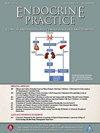Objective Measures of Cardiometabolic Risk and Advanced Fibrosis Risk Progression in Primary Care Patients With Metabolic Dysfunction-Associated Steatotic Liver Disease
IF 3.7
3区 医学
Q2 ENDOCRINOLOGY & METABOLISM
引用次数: 0
Abstract
Background
We examined the association of objective measures of cardiometabolic risk with progression to a high-risk for advanced fibrosis in patients with metabolic dysfunction-associated steatotic liver disease (MASLD) at initially low- and indeterminate-risk for advanced fibrosis.
Methods
We performed a retrospective cohort study of primary care patients with MASLD between 2012 and 2021. We evaluated patients with MASLD and low- or indeterminate-risk Fibrosis-4 Index (FIB-4) scores and followed them until the outcome of a high-risk FIB-4 (≥2.67), or the end of the study period. Exposures of interest were body mass index, systolic blood pressure, hemoglobin A1c, cholesterol, estimated glomerular filtration rate, and smoking status. Variables were categorized by the threshold for primary care therapy intensification. Unadjusted and adjusted Cox regression models were developed for the outcome of time to a high-risk FIB-4 value.
Results
The cohort included 1347 patients with a mean follow-up of 3.6 years (SD 2.7). Of the cohort, 258 (19%) had a subsequent FIB-4 > 2.67. In the fully adjusted Cox regression models, mean systolic blood pressure ≥ 150 mm Hg (1.57; 95% confidence interval (CI) 1.02-2.41) and glomerular filtration rate ≤ 59 ml/min (hazard ratio 2.78; 95%CI 2.17-3.58) were associated with an increased hazard of a high-risk FIB-4, while receiving a statin prescription (hazard ratio 0.51; 95%CI 0.39-0.66) was associated with a lower risk.
Conclusions
Nearly 1 in 5 primary care patients with MASLD transitioned to a high-risk FIB-4 score during 3.6 years of follow-up, and uncontrolled blood pressure and reduced kidney function were associated with an increased hazard of a FIB-4 at high-risk for advanced fibrosis.
对患有代谢功能障碍相关脂肪性肝病的初级保健患者的心脏代谢风险和晚期纤维化风险进展进行客观测量。
背景:我们研究了心血管代谢风险的客观指标与MASLD患者进展为晚期纤维化高风险的相关性:我们对 2012 年至 2021 年间的 MASLD 初级保健患者进行了一项回顾性队列研究。我们对MASLD和低风险或不确定风险的纤维化-4指数(FIB-4)评分患者进行了评估,并随访至高风险FIB-4(>2.67)或研究期结束。研究对象的暴露指标包括体重指数(BMI)、收缩压(SBP)、血红蛋白 A1c、胆固醇、估计肾小球滤过率(eGFR)和吸烟状况。变量按初级保健强化治疗的阈值进行分类。针对出现高风险 FIB-4 值的时间结果,建立了未经调整和调整的 Cox 回归模型:该队列包括 1347 名患者,平均随访 3.6 年(标清 2.7)。其中 258 人(19%)的后续 FIB-4 值大于 2.67。在完全调整后的 Cox 回归模型中,平均 SBP > 150 mm Hg (1.57; 95%CI 1.02-2.41)和 eGFR < 59 ml/min (HR 2.78; 95%CI 2.17-3.58)与高风险 FIB-4 的风险增加有关,而接受他汀类药物处方 (HR 0.51; 95%CI 0.39-0.66) 则与风险降低有关:结论:在3.6年的随访中,近五分之一的MASLD初治患者转为高风险FIB-4评分,未控制的血压和肾功能减退与FIB-4高风险晚期纤维化的风险增加有关。
本文章由计算机程序翻译,如有差异,请以英文原文为准。
求助全文
约1分钟内获得全文
求助全文
来源期刊

Endocrine Practice
ENDOCRINOLOGY & METABOLISM-
CiteScore
7.60
自引率
2.40%
发文量
546
审稿时长
41 days
期刊介绍:
Endocrine Practice (ISSN: 1530-891X), a peer-reviewed journal published twelve times a year, is the official journal of the American Association of Clinical Endocrinologists (AACE). The primary mission of Endocrine Practice is to enhance the health care of patients with endocrine diseases through continuing education of practicing endocrinologists.
 求助内容:
求助内容: 应助结果提醒方式:
应助结果提醒方式:


